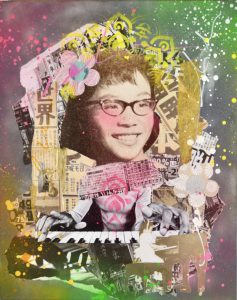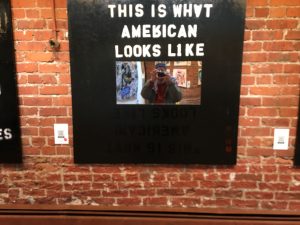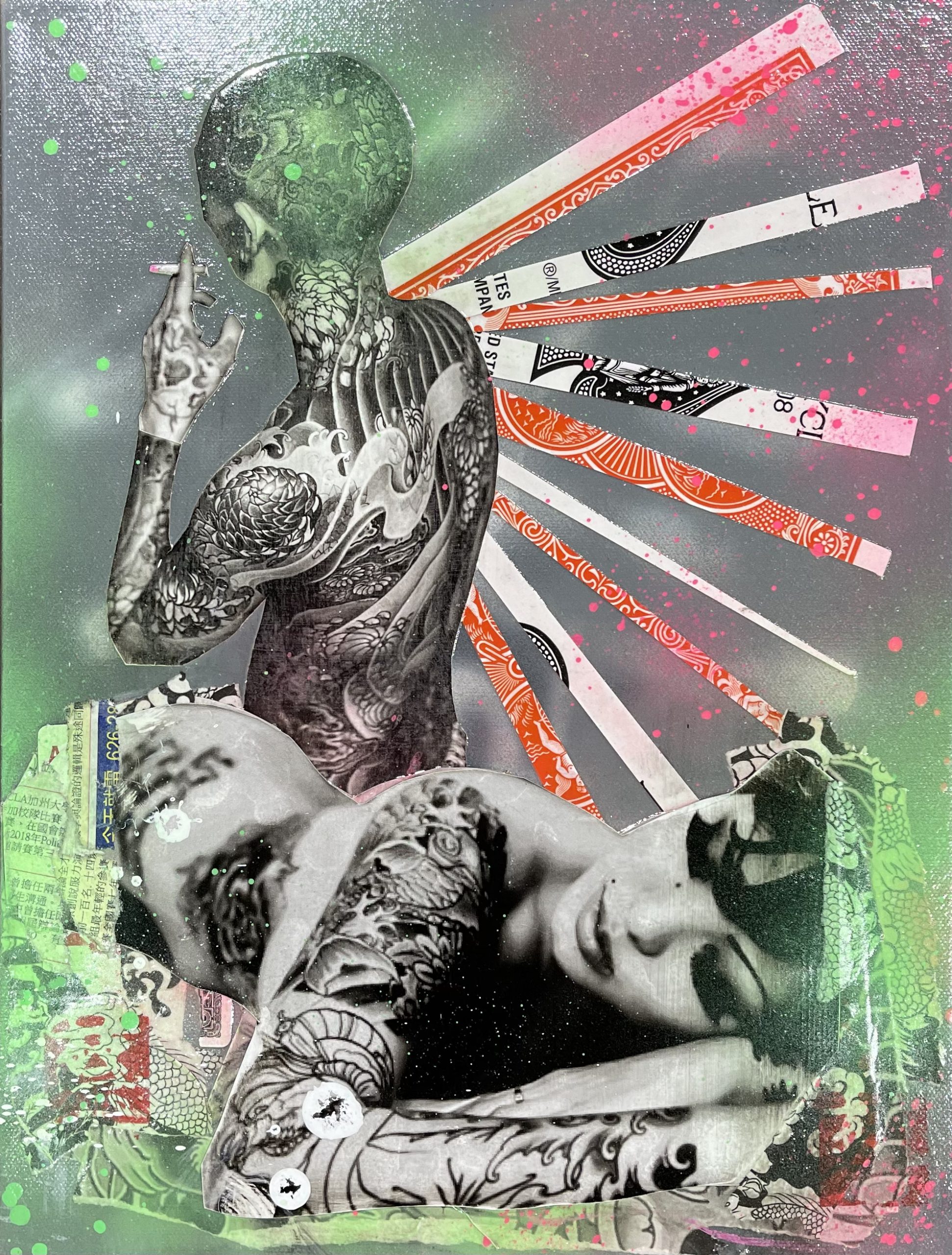A recent art exhibit in San Francisco got me thinking about immigrants and immigration, which has long been a hot topic in the US. I can relate on a personal level. Rodney Toy, 53, the artist whose powerful work was exhibited at the Canessa Gallery, is a descendant of a Chinese couple who arrived in California under the name Choy. Rodney doesn’t know if his grandparents changed their last name, or if Customs and Immigration did it.
In any case, he’s disconnected from parts of his own past, as I am from mine. In Russia, my mother’s family name was Kvitkov. At Ellis Island, immigration officials changed it to Quitkin. Family legend has it that the Kvitkovs were escaping from persecution against Jews. My grandmother, Ida, hid in the basement of non-Jews and avoided a “pogrom,” which Wikipedia defines as a “violent riot incited with the aim of massacring or expelling an ethnic or religious group, particularly Jews.”
My grandfather, Aaron Quitkin, a writer and intellectual, ran away from Russia to avoid military service in the Czar’s army. In the US, he became a socialist and a supporter of Eugene Victor Debs, who ran for president four times, once when Debs was in prison. The Quitkins did not arrive in chains, and unlike blacks they were never slaves, though they faced discrimination and they were hard hit by the Depression of the 1930s. They also belonged to lefty organizations and thought of themselves as working class. Going to the Quitkin apartment in Brooklyn from my boyhood home on Long Island felt like going back in time to the Old World.
My father’s parents, who arrived at Ellis Island as immigrants from Russia, started poor and slowly worked their way up the economic ladder. My father’s father, Benjamin, made enough money as a peddler to open a modest dry goods store where he sold shoes, trousers, and shirts to immigrants from Italy, Poland and Russia who settled in Huntington, Long Island where I was born and raised and where white Anglo Saxon Protestants (aka “WASPS”) were at the top of the pecking order and blacks (known as “Negroes” in those days) were near the bottom.
Like the American historian, Roxanne Dunbar-Ortiz, the author of a new book, Not a Nation of Immigrants, subtitled ”Settler Colonialism, White Supremacy and a History of Erasure and Exclusion,” Toy is keenly aware of the “erasure and exclusion” of the Chinese in particular who were specifically barred from entry to the US by the Exclusion Act of 1882. It was the first and the only major federal legislation to suspend immigration for a specific ethnic group. The act was not repealed until 1943, just in time for Executive Order 9066, which allowed for the incarceration of 120,000 Japanese Americans during WWII.
Toy is partial to the Chinese, but he has more than the Chinese in mind when he thinks about erasure and exclusion. In the program notes for his exhibit, he denounces discrimination against Muslims. He also criticizes the building of the wall on the border with Mexico, and points out that at various times in US history, groups and individuals with “negative attitudes” about “race and ethnicity,” have engaged in acts of violence against people of color. Lawmakers, he adds, have passed “discriminatory” legislation.
Toy lambasts the administration of our 45th president. As a kind of snub, he refuses to use the name Donald Trump. But he denounces the rhetoric, programs and tactics of the Trump White House, ridicules the oft-heard notion that Asians are “almost white,” and in the spirit of love that MLK preached, calls for genuine diversity and real inclusivity.
Two years ago, during the worst of the pandemic, and in the midst of the rising tide of “Asian hate”— which he observed first hand— Toy decided he would make art, no longer behave like “Mr. Nice Guy,” and that he would lampoon the notion that Asians were a “Model Minority.” The hate and hostility he witnessed generated a wave of creativity and art.
“Rising Son” was the name of his exhibit at the Canessa Gallery, near Chinatown where he spent significant time during his childhood. The show in the winter of 2022 brought together 31 individual pieces, many of them mixed media collages, often with wordplay, some with overt messages and others, non-representational inspired by pivotal avant-garde artists such as the American abstract expressionist, Jackson Pollock.
“In 2020, the escalating anti-Asian rhetoric forced me to take a critical look at myself and how I should respond,” Toy told me on a Sunday afternoon at the gallery where we were surrounded by his work and his admirers, most of them enthusiastic Chinese friends and family members. Toy added, “In the midst of the anti-Asian rhetoric, I decided to use my art as a megaphone.”
“Son” is the key word in the title of the exhibit. It’s an intentional play on the phrase, “Rising Sun,” which is often associated with Asia and Asians. Toy calls “Son” an “ode” to his parents.
The piece that attracted the most attention and held it at the opening is called “Immigration Sensation.” There’s a mirror at the center of a wood panel and a text that reads “This is What American Looks like” with the letter “A” in the word “What” reversed, and the letter “R” in the word “American” also reversed. Rodney’s friends and family members peered into the mirror, saw a reflection of themselves and felt seen, recognized and acknowledged. Indeed, they weren’t erased or excluded. I experienced much the same feeling.
Another work that attracted a great deal of attention proclaims, “Don’t Believe the Stereotypes.” It offers white letters on a black background with the word “Believe” broken in two so that on one line it reads “Beli” and on another line below it, “eve.” Those simple changes generated a major impact on viewers.
Toy explained, “I made this piece with stereotypes in mind.” He added, “I am looking to shatter my own biases that generally lead me to avoid sensitive and politically charged topics that might upset others and instead push myself to speak freely regardless of what others might think.”
“Choy,” a 30” x 40” canvas that greeted visitors to the gallery, was made with both acrylic and spray paint, and was inspired by traditional Chinese calligraphy. Clearly, it redeems the family name as well as family history. Toy’s Choy ancestors were acknowledged and honored.
Another work, “Perfect Pitch,” offers a photo of his mother, once a talented performance pianist, plus the hands of Stevie Wonder on a keyboard. Black and Asian meet.

Rodney’s father, who had been a school principal, was his first real hero. He died over 35 years ago, but left a lasting impression on his son.
“Caution: Do Not Work” features a strip of yellow tape with the word “CAUTION” in capital letters. The yellow strip was used to block off a section of seats at the SAP Center, often referred to as the “Shark Tank,” where Rodney has often watched ice hockey, not far from his home in San Jose. He’s one face among many in a multi-ethnic crowd.
“FTP-Z” incorporates photos of his sons, Cameron and Brendan, and was inspired, Toy explains, by “modern street wear, surf & skateboard graphics.”
“Season Pass” includes an image of the artist’s own Audi R8 convertible, and another one of the Golden Gate Bridge, a Bay Area icon, as viewed from Marin. No single ethnic group can claim the bridge as its own landmark; it belongs to everyone.
In the spirit of the writers of the Beat Generation, Toy also allows for spontaneity and improvisation. To make the piece, “Pink, Pink Used Ink,” he flicked off the bright lights in his studio and turned it into a dark room where he could use a light-sensitive emulsion. The resulting color scheme—pink, yellow and orange—is psychedelic.
For art lovers who don’t want messages, Toy had much to offer, especially in a series called “Geode,” and a large work titled “Re-Entry” that he created by adding paint to an ordinary dustpan and pouring the mixture on the canvas.
“I’ve always been an optimist,” Toy told me on the day his exhibit opened. He’s also a sentimentalist who’d like to go back to his boyhood when the whole family gathered every Sunday at his grandmother’s house in Oakland and ate real Chinese food. I’m sorry I wasn’t at the table with them, though I was reminded of the Sunday afternoons in my boyhood when my parents took me and my brothers for scrumptious Chinese food at a local restaurant owned and operated by a friend.


